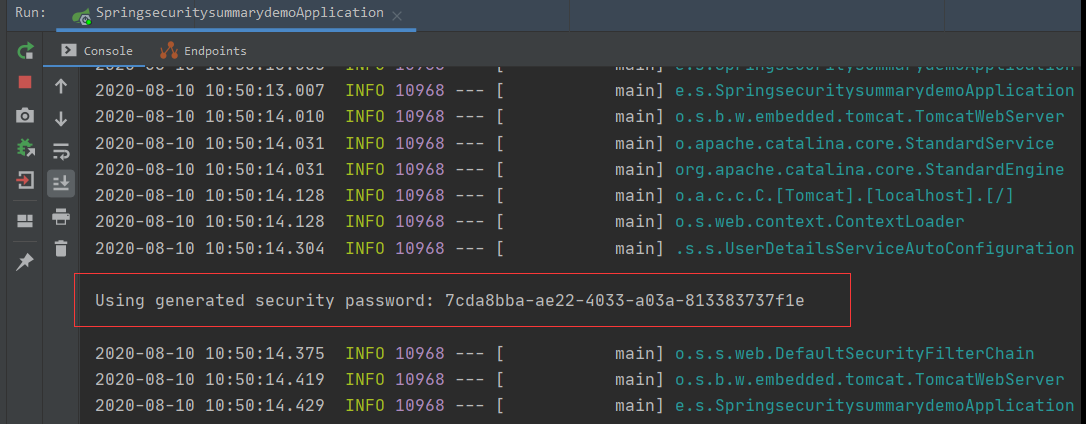【Spring Security】1.快速入门
1 导入Spring Security的相关依赖
<dependency> <groupId>org.springframework.boot</groupId> <artifactId>spring-boot-starter-security</artifactId> </dependency> <dependency> <groupId>org.springframework.boot</groupId> <artifactId>spring-boot-starter-web</artifactId> </dependency>
2 Spring Security认证方式之Http基本认证
2.1 实现流程
-
Http基本认证是最简单的认证方式,不需要任何配置,导入依赖启动应用后就会弹出默认的httpBasic认证框。也相当于在实现了BrowserSecurityConfig类进行了如下配置:
@Configuration public class BrowserSecurityConfig extends WebSecurityConfigurerAdapter { @Override protected void configure(HttpSecurity http) throws Exception { //HttpBasic的alert框登录 http.httpBasic() .and() .authorizeRequests()//对请求进行授权 .anyRequest()//任何请求 .authenticated(); } }
在Spring Security的默认配置中,使用用户名user,密码为控制台打印的随机码。

-
可以在resources配置文件中修改默认的用户名和密码,指定密码后控制台不再生成动态的随机码。
- properties配置
-
security.user.name=user security.user.password=123456
- yml配置
-
spring: security: user: name: user password: 123456
2.2 Http基本认证原理

-
客户端向服务端请求被保护的资源,服务端向客户端请求用户名和密码,浏览器弹出登录输入框,HttpBasic模式要求传输的用户名密码使用Base64模式进行加密。客户端向服务端发起login的请求。
-
客户端发送的Http请求中会使用Authorization作为Header,即“Basic + 空格 + Base64密码”。而Base64很容易被逆向解码,所以HttpBstic的认证方式是不安全的。

服务器接收到请求后,到达BasicAuthenticationFilter过滤器,将提取Header值,并使用用于验证用户身份的相同算法Base64进行解码。解码结果与登录验证的用户名密码匹配,匹配成功则可以继续过滤器后续的访问。
2.3 小结
Http认证虽然配置简单,但是安全性极差,灵活性不高,无法携带cookie,所以一般应用会用安全性和灵活性更强的表单认证方式,可以通过自定义登录和验证逻辑,提高安全性。
3 表单认证
3.1 实现流程
-
配置使用自定义的表单登录
@Configuration public class BrowserSecurityConfig extends WebSecurityConfigurerAdapter { @Override protected void configure(HttpSecurity http) throws Exception { // 表单登录,而不是httpBasic http.formLogin() // 自定义登录页面 .loginPage("login.html") // 指定处理登录请求的路径 .loginProcessingUrl("/login") // 不限制登录页面的访问 .permitAll() .and() .authorizeRequests()//对请求进行授权 .anyRequest()//任何请求 .authenticated() .and() .csrf() .disable(); } }
-
自定义认证成功/失败的处理逻辑
Spring Security中默认的成功处理逻辑定义在AbstractAuthenticationTargetUrlRequestHandler类中,在发送登录请求并认证成功后页面会跳转回到原来的访问页面,页面跳转不适用于前后端分离的系统中,因此可以自定义成功后的处理逻辑,登录后返回JSON数据。
实现AuthenticationSuccessHandler和 AuthenticationFailureHandle类中的处理方法。
@Component("customAuthenticationSuccessHandler") public class CustomAuthenticationSuccessHandler implements AuthenticationSuccessHandler { @Autowired private ObjectMapper objectMapper; @Override public void onAuthenticationSuccess(HttpServletRequest httpServletRequest, HttpServletResponse httpServletResponse, Authentication authentication) throws IOException, ServletException { httpServletResponse.setContentType("application/json;charset=UTF-8"); httpServletResponse.getWriter().write(objectMapper.writeValueAsString(authentication)); } }@Component("customAuthenticationFailureHandler") public class CustomAuthenticationFailureHandler implements AuthenticationFailureHandler { @Override public void onAuthenticationFailure(HttpServletRequest httpServletRequest, HttpServletResponse httpServletResponse, AuthenticationException e) throws IOException, ServletException { log.info("登录失败"); httpServletResponse.setStatus(HttpStatus.SC_INTERNAL_SERVER_ERROR); httpServletResponse.setContentType("application/json;charset=UTF-8"); httpServletResponse.getWriter().write(e.getMessage()); } }
在WebSecurity配置文件中配置自定义的处理器
@Configuration public class BrowserSecurityConfig extends WebSecurityConfigurerAdapter { @Override protected void configure(HttpSecurity http) throws Exception { // 表单登录,而不是httpBasic http.formLogin() // 自定义登录页面 .loginPage("login.html") // 不限制登录页面的访问 .permitAll() // 自定义认证后的处理器 .successHandler(customAuthenticationSuccessHandler) .failureHandler(customAuthenticationFailureHandler) .and() .authorizeRequests()//对请求进行授权 .anyRequest()//任何请求 .authenticated() .and() .csrf() .disable(); } }
3.2 关于HttpSecurity
在配置文件中使用HttpSecurity进行HTTP请求安全策略的配置,HttpSecurity被设计为链式调用,执行每个方法会返回一个预期的上下文,用于连续调用,其中:
-
authorizeRequests()相当于XML中的<intercept-url>标签,它返回一个URL拦截注册器,可以调用它提供的anyRequest()、antMatchers()、regexMatchers()等方法来匹配系统的URL,并为它指定安全策略。
-
formLogin()相当于XML中的<form-login>标签,声明了需要Spring Security提供的表单认证方式,返回对应的配置器,loginPage()用于指定自定义的登录页面。Spring Security会为该登录页注册一个POST路由用于接收登录请求。
-
httpBasic()相当于XML中的<http-basic>标签
-
csrf()相当于XML中的<csrf>标签,提供了跨站请求伪造防护功能,继承WebSecurityConfigurerAdapter会默认开启csrf()方法。
使用and()方法可以结束当前标签,上下文会回到HttpSecurity,否则链式调用的上下文会自动进入对应的标签域。





 浙公网安备 33010602011771号
浙公网安备 33010602011771号